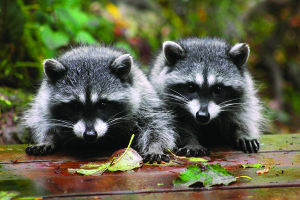How to keep unwanted creatures from your yard
It’s probably every dog owners worst nightmare. You let Fido out into the back yard for some fresh air and he comes face to face with a skunk.
Let’s face it – Barrhaven is very much a rural enclave surrounded by large swaths of wilderness. For the most part, we co-exist peacefully with the wild animals that surround us, but it’s not unheard of to have the odd coyote or wild turkey get a little to close for comfort. Others, such as skunks and raccoons pretty much think they are part of the community.
Today I want to share some tips on how to discourage wild animals from making your backyard their home. And who knows, we might even save Fido from an unpleasant experience.
 (NC) Woodland animals may look harmless, but they can cause serious damage to your home and yard. They’re capable of physical confrontation, spreading disease, causing odours, creating noise disturbances, destroying landscaping and vegetable gardens and even chewing through wires. While these pests are typically thought of as a rural issue, experts note that our cohabitation with nature will always bring pest issues.
(NC) Woodland animals may look harmless, but they can cause serious damage to your home and yard. They’re capable of physical confrontation, spreading disease, causing odours, creating noise disturbances, destroying landscaping and vegetable gardens and even chewing through wires. While these pests are typically thought of as a rural issue, experts note that our cohabitation with nature will always bring pest issues.
“Even the most urban settings can experience wildlife and its associated issues – ranging from simple annoyances or bold attacks to serious health risks,” says Alice Sinia, Ph.D., resident entomologist with Orkin Canada. “These pests can be particularly difficult to treat reactively so taking preventative measures is the best solution when dealing with wildlife.”
Experts at Orkin recommend these tips to protect your yard from the wild this fall:
W – Waste containers and trashcans should be made of tough material like hard plastic or metal and should have tight-fitting lids. Make sure they are securely supported so nocturnal food raiders can’t tip them over.
I – Inspect and monitor for accumulations of moisture on the roof, around air conditioners and in other favourable nesting locations. Birds and wildlife, like all pests, are constantly in search of water sources and most, only need minimal amounts to survive.
L – Lawns should be clear of tall grasses and brush. Maintain landscaping by treating for grubs, or beetle larvae, as they can be a food source for raccoons and other wildlife. Keep trees and vegetation trimmed at least half a metre away from your home to limit pest access.
D – Discourage infestations through quick action. While some wildlife, like raccoons, are stealthy, others, like birds, are not. Infestations usually become evident with the increase of adult birds, the frequent occurrence of chirping, the sighting of nests, and an increased quantity of droppings in the area. If you suspect a problem, contact your local pest control provider immediately.
The great outdoors provides a breath of fresh air, and fall is the perfect seasonal window to the wild. Proper pest management can help reduce the associated wildlife risks. Should you experience issues, a pest management company can tailor a program specific to the habitat and biology around your home.




